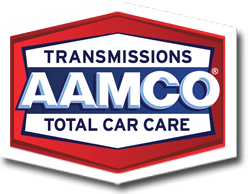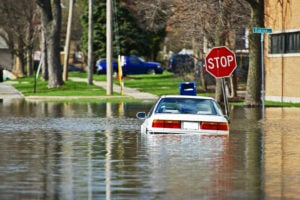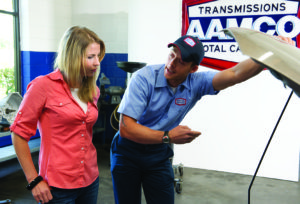It can be difficult to tell if a car has been in a flood or hurricane.
With bigger and wetter storms, water-damaged vehicles will be flooding the used car market.
Learn the warning signs and hazards of buying a flood-damaged car.
When you’re looking at used cars, how do you avoid vehicles that have been in floods or hurricane storm surges? Water wreaks havoc on cars in many ways. Most vehicles involved in floods are declared a total loss by insurance companies. This is because water-damaged vehicles are difficult and expensive to repair – if they can be repaired at all. Water damage severely limits a car’s reliability and longevity but is easy to hide from most people who are not really looking for signs of water damage.
In this age of frequent and disastrous storms, more and more cars become susceptible to all kinds of damage. There are expected to be almost a million vehicles damaged as a result of Hurricane Harvey. Hurricane Irma added to that total to create a potential wave of cars that have suffered damage and are being resold, either legitimately or not. Learn what to look for and avoid being suckered into buying a nice looking used car that will cost you thousands in repairs.
 A car damaged by water can cost you more money in the long run.
A car damaged by water can cost you more money in the long run.
There are things you can do and look for in your own inspection of the vehicle.
Check the vehicle identification number (VIN).
Even if the paperwork says the car is legit and clean, it might be forged. For a small fee, you can check the vehicle identification number (VIN) with a service like CarFax. It’s easy and can potentially save you a lot of headaches and money. You can usually find the car’s VIN on an aluminum plate bolted on the dash, or on the inside of the door, adhered securely to the frame of the car. If you can’t find the VIN anywhere, and the seller doesn’t have or know it, that’s a pretty sure sign you should consider looking elsewhere.
A VIN check report will show terms like “flood”, “salvage”, “rebuilt”, or “loss.” Keep in mind that if the seller or previous owner didn’t have the car insured, then any damage might not have been reported to anyone, hence not in any records database. That’s why the next few things you can do are important.
 Get the car inspected by a professional mechanic before you buy it.
Get the car inspected by a professional mechanic before you buy it.
The car looks great, is priced right, and the seller is friendly and motivated. First things first. Tell the seller you’re going to have the car inspected by a professional mechanic. If the seller shows any resistance, protests, or wants his mechanic to look at it for you, walk away. It’s your hard-earned money and the seller is probably hiding something about the car.
Related: AAMCO Used Car Pre-Purchase Inspection
Test drive the car.
By all means, take the car for a test drive. Don’t be afraid to push it a little and test it in as many conditions as you can – city, highway, hills, curves. Listen for abnormal sounds and be wary of vibrations, steering pull, shuddering, shaking, or any other odd behavior that a solid, well-maintained car should not exhibit. Run systems like AC and heat full blast. Test everything, especially electrical – radio included. Speakers sometimes are susceptible to shorts, so they can be a good indicator of something amiss in the electrical system. One or two odd things might be nothing much to worry about, but when combined with a number of other issues, it could mean water damage.
With so many cars being totaled by storms, how else can you tell if the one you want has been damaged?
Given that there will probably be a much larger number of flood-damaged cars on the market in the coming months, or even years (there will be more storms), you should educate yourself if you’re looking to buy a used car anytime soon. There are a few things you can look out for when looking at used cars that you suspect might come from a storm-ravaged region. Water is a force of nature, so it can damage or destroy anything. Symptoms of a water-damaged car are exhibited by some of the primary systems of a car, as well as other cosmetic areas.
What’s that smell?
Flooded cars oftentimes smell musty inside. Water or liquid stains on the upholstery might be expected, but it’s difficult to fully dry a car interior after it’s been submerged. You might have to get close to the carpet or the seats, but if you sniff deeply and get a hint of mildew or some other scent that reminds you of not-so-fresh water, the car has probably been through a few feet of water. There is no amount of air freshener that will kill those smells. And speaking of air freshener… If the car smells strongly of air freshener, to the point that it’s overpowering, there is a good chance the seller is trying to cover up another not-so-sellable odor altogether.
Mold and mildew are difficult to deal with at the level of smell, much less outright detection and removal. Short of tearing out all the interior carpeting, seats, and heading, you’ll most likely end up living with an unpleasant odor that might come and go, be less or worse depending on the weather and temperature.
That’s an interesting shade of rust.
Rust and corrosion that seems too much for a car in such supposedly good condition is an indicator of possible deeper issues. Take the time to thoroughly look under the car, under the hood, and closely at things like battery connections, gas caps, inside door frames, and in wheel wells. Residual dirt, mud, or excess grime in odd places should be questioned. In extreme cases, you might even notice a water line or stain along with the doors or panels, outside or in.
 It’s shocking what water can do to a car.
It’s shocking what water can do to a car.
Electrical problems are common, and oftentimes are difficult to diagnose and fix because the entirety of the electrical system has been affected. This is one of the most costly systems to be affected by water. Check exterior lights – headlights, turn signals, brake lights, reverse and license plate lights – and interior lights like the overhead, glove box, trunk, hood. If any dashboard lights or instruments are not working, there might be an issue. If the car has power windows and locks, check every single one from both the driver side main console and the individual door controls.
If the car’s performance is all wishy-washy…
Engine problems are obviously going to be seen with cars that have been immersed in water. Water in critical lines and tanks, especially oil lines and gas tanks, are difficult and costly to fix, and most likely will cause problems for years to come.
AAMCO Colorado
It’s important to pay special attention to anything unusual or that you would not expect as you go through these steps. Take notes and schedule a pre-purchase inspection with your local AAMCO Colorado certified mechanics to thoroughly check the car you’re interested in buying. If you’ve already bought the car and you need help diagnosing a problem, or need repairs, schedule an appointment online or call your local Colorado AAMCO.
If you have questions about your car’s road readiness, or about car repair and maintenance topics, AAMCO Colorado can help. You can also go online and use the AAMCO Colorado Ask a Mechanic feature to submit your auto repair questions. They will be answered by a real AAMCO Colorado mechanic as soon as possible. And don’t forget to check out our Transmission and Automotive Repair FAQ.




Hi just picked up 2012 dual cab Colorado diesel from car yard yesterday. They put fuel in it on delivery, tried to start today & it said water in terrant system & wouldn’t start, is this fixable by changing fuel filter or is it stuffed & I bought a lemon
Melissa,
While it’s hard for us to diagnose your exact problem online, we would be happy to do a free vehicle courtesy check at any of our 14 AAMCO Colorado locations to help you determine the problem with your vehicle. Good luck!
Thanks,
AAMCO Colorado